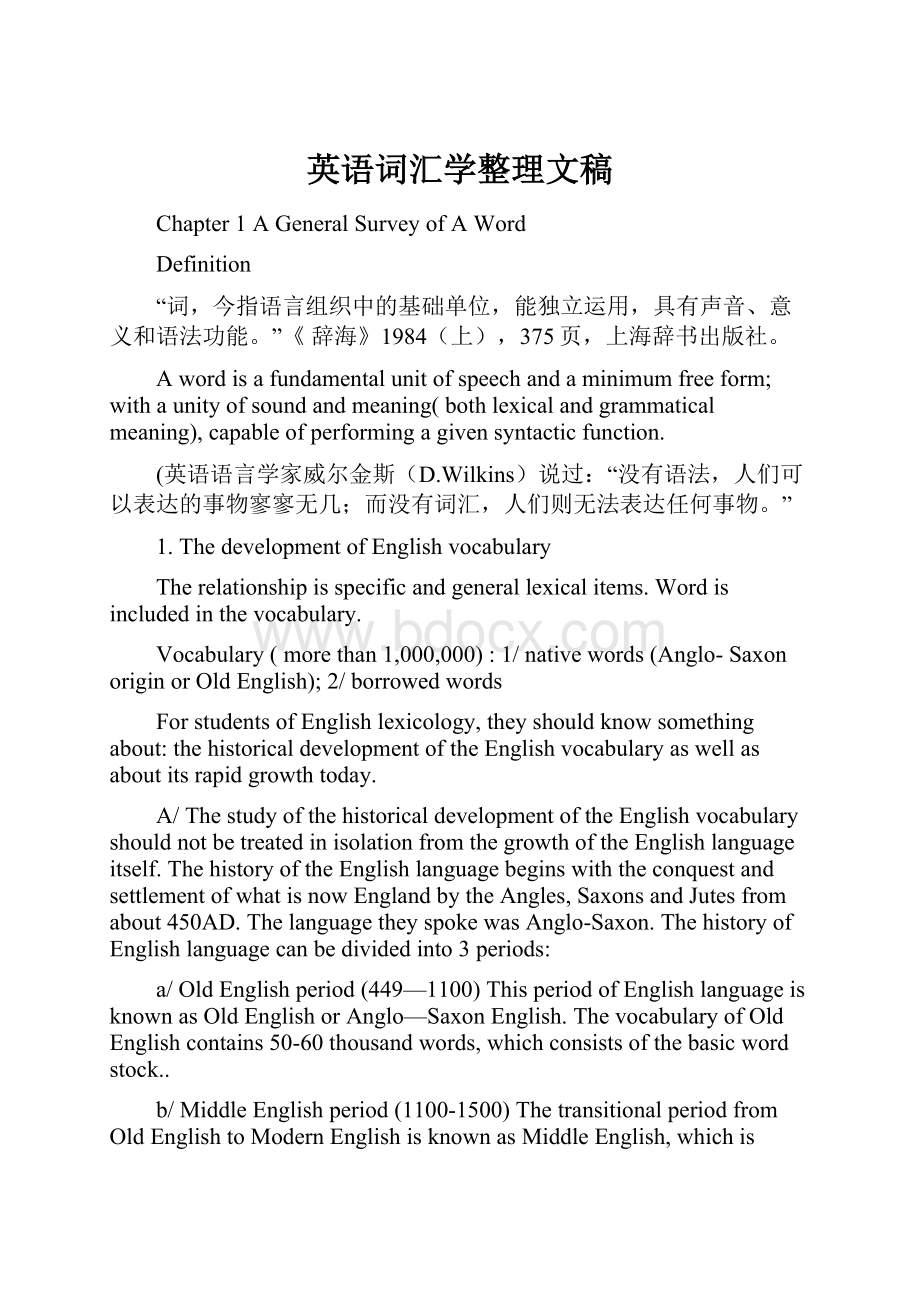 英语词汇学整理文稿.docx
英语词汇学整理文稿.docx
- 文档编号:11248975
- 上传时间:2023-02-26
- 格式:DOCX
- 页数:44
- 大小:49.72KB
英语词汇学整理文稿.docx
《英语词汇学整理文稿.docx》由会员分享,可在线阅读,更多相关《英语词汇学整理文稿.docx(44页珍藏版)》请在冰豆网上搜索。

英语词汇学整理文稿
Chapter1AGeneralSurveyofAWord
Definition
“词,今指语言组织中的基础单位,能独立运用,具有声音、意义和语法功能。
”《辞海》1984(上),375页,上海辞书出版社。
Awordisafundamentalunitofspeechandaminimumfreeform;withaunityofsoundandmeaning(bothlexicalandgrammaticalmeaning),capableofperformingagivensyntacticfunction.
(英语语言学家威尔金斯(D.Wilkins)说过:
“没有语法,人们可以表达的事物寥寥无几;而没有词汇,人们则无法表达任何事物。
”
1.ThedevelopmentofEnglishvocabulary
Therelationshipisspecificandgenerallexicalitems.Wordisincludedinthevocabulary.
Vocabulary(morethan1,000,000):
1/nativewords(Anglo-SaxonoriginorOldEnglish);2/borrowedwords
ForstudentsofEnglishlexicology,theyshouldknowsomethingabout:
thehistoricaldevelopmentoftheEnglishvocabularyaswellasaboutitsrapidgrowthtoday.
A/ThestudyofthehistoricaldevelopmentoftheEnglishvocabularyshouldnotbetreatedinisolationfromthegrowthoftheEnglishlanguageitself.ThehistoryoftheEnglishlanguagebeginswiththeconquestandsettlementofwhatisnowEnglandbytheAngles,SaxonsandJutesfromabout450AD.ThelanguagetheyspokewasAnglo-Saxon.ThehistoryofEnglishlanguagecanbedividedinto3periods:
a/OldEnglishperiod(449—1100)ThisperiodofEnglishlanguageisknownasOldEnglishorAnglo—SaxonEnglish.ThevocabularyofOldEnglishcontains50-60thousandwords,whichconsistsofthebasicwordstock..
b/MiddleEnglishperiod(1100-1500)ThetransitionalperiodfromOldEnglishtoModernEnglishisknownasMiddleEnglish,whichischaracterizedbythestronginfluenceofFrenchfollowingtheNormanConquestin1066.
c/ModernEnglishperiod(1500--)TheEnglishlanguagefrom1500tothepresentiscalledModernEnglish.Intheearlystageofthisperiod(includingtheyearsbetween1500-1700),theRenaissancebroughtgreatchangestothevocabulary.Inthisperiod,thestudyofclassicswerestressedandresultwasthewholesaleborrowingfromLatin.
B/Therapidgrowthofpresent-dayEnglishvocabulary(esp.aftertheWorldWarII)andthecauses.AftertheWorldWarII,neologismssweptinataratemuchfasterthanthatofthepre-warperiod.
Mainreasons:
①markedprogressofscienceandtechnology②socio-economic,politicalandculturalchanges③theinfluencefromotherculturesandlanguages
2.ClassificationofEnglishWordsAccordingtoDifferentCriteria
A.ByOrigin:
nativewordsandloan(borrowed)words
WordsofAnglo-SaxonoriginorofOldEnglisharenativewords,whilethoseborrowedfromotherlanguagesareloan/borrowedwords.
InEnglishlanguage,mostnativewordsinModernEnglisharemonosyllabic.TheyformthegreatmajorityofthebasicwordstockofEnglishlanguage.
Thefundamentalfeaturesofthebasicwordstockare:
1.Nationalcharacter2.Stability3.Word-formingability4.Abilitytoformcollocations
Sincethegreatmajorityofthebasicwordstockarenativewords,theyarenaturallytheonesusedmostfrequentlyineverydayspeechandwriting.
B.Bylevelofusage
1.Commonwords(P11)2.Literarywords(P12)a.Archaicwordsb.Poeticalwords
3.Colloquialwords4.Slangwords5.Technicalwords
C.Bynotion:
functionwordsandcontentwords(P17)
3.SoundandMeaningofaWord
2schoolsabouttherelationofsoundandmeaningofaword:
a/theNaturalists:
Theiropinionisthatthereisanintrinsiccorrespondencebetweensoundandmeaning.
b/theConventionalists:
withanopinionthattherelationbetweensoundandmeaningofawordisakindoflinguisticsocialcontract.
UsetheexamplesonP2toillustratetheopinionsofthe2schools.
LexicalandGrammaticalMeaningofaWord
•Thereisacloserelationbetweenlexicalandgrammaticalmeaningofaword;lexicalmeaningischangingwiththechangeingrammaticalmeaning.
MeaningandConceptofaWord:
Meaningiscloselyrelatedtoaconcept.Aconceptisthebaseofthemeaningofaword.Awordisusedtolabelaconcept.Itactsasthesymbolforthatconcept.Theconceptisabstractedfromtheperson,thing,relationship,idea,event,andsoon,thatwearethinkingabout.Wecallthisthereferent.Thewordlabelstheconcept,whichisabstractedfromthereferent;theworddenotesthereferent,butdoesnotlabelit.Theirrelationcanbediagrammedasfollows:
Word---Meaning(concept)---referent
词意义(概念)所指对象
Thisformulashowsthatthewordreferstothereferentthroughaconcept.
Aconceptisanabstractionfromthingsofthesamekind.
Notes:
1/词由一定的形式(发音与书写)
2/每个词都有一定的形式与概念,这两方面缺一不可,统一在每个词中。
3/词义与所指对象连接在一起---一方面,词义在客观世界中是有所指的,另一方面,词义又是客观世界中的某一(某些)事物在语言中的反映。
客观世界是无穷无尽,无限丰富的,客观世界中的事物之间存在着细微的千差万别,人类的语言是不能完完全全地准确反映客观世界。
Chapter2MorphologicalStructureofEnglishWords
I.Morpheme(形位,词素,语素)
1.Somebasicinformationaboutmorphemes
A.Amorphemeisthesmallestmeaningfullinguisticunitoflanguage,notdivisibleoranalyzableintosmallerforms.
AwordinEnglishmaybeanalyzableintooneormoremorphemes.
onemorpheme---------nationtwomorphemes--------nation-al
3morphemes---------nation-al-ize4 morphemes---------nation-al-iz-ation
morethan4morphemes--------de-nation-al-iz-ation
2.Amorphemeisalsoatwo-facetlanguageunitwhichpossessesbothsoundandmeaning.Itisthereforedifferentfromaphoneme(音素),whichonlyconveyssounddistinction.Amorphemeisnotidenticalwithasyllable,either;sincethelatterhasnothingtodowithmeaning.Amorphememayberepresentedbyonesyllable,like‘boy’or‘child’,orbytwoormoresyllables,asin‘la-dy,croc-o-dile’.Oftenthesyllabicstructureofawordanditsmorphemicstructuredonotcorrespond(一致),asshownintheaboveexampleswhereamorphemeisrepresentedbymorethanonesyllable.Anothergoodexampleistheword‘dis-a-gree-a-ble’,whichconsistsof5syllablesagainst3morphemes‘dis-agree-able’.
3.Contentmorpheme,grammaticalmorphemeandallomorph(形位变体)
1.Afreemorphemeisonethatcanbeutteredalonewithmeaning.Itcanexistonitsownwithoutagrammaticalmorpheme.Afreemorphemeisawordinthetraditionalsense.Itservesastheroot.e.g.man,boy,read,write,red,doetc.
2.Agrammaticalmorphemecan’tstandbyitselfasacompleteutterance;itmustappearwithatleastoneothermorpheme,freeorbound(contentorgrammatical).
e.g.un→unkind,ly→happily,ed→worked,s→dogs,es→boxes,re→receive(twoboundmorphemes).Itservesasaffixes.
Morphemesmaybeclassifiedintofree(content)morphemesandbound(grammatical)morphemes.Arootisthebasicunchangeablepartofaword,anditconveysthemainlexicalmeaningoftheword.
e.g.work,worked,workable,works,worker,working.Therootineachwordhereis‘work’,whichisthebasicunchangeablepart,carryingthemainlexicalmeaning.Roots,therefore,arethecoresofEnglishwords,belongingtothebasicwordstock.
OpaquewordsTransparentwords
II.Allomorph(形位变体)
Anallomorphisanyofthevariantformsofamorphemeasconditionedbypositionoradjoining(相临的,毗邻的)sounds.(Webster’sNewWorldDictionaryofTheAmericanLanguage).e.g.cats→beds→oranges
Fromtheexamplesabove,wecanseethat–shasthreedifferentphonologicalforms:
/s/,/z/,/iz/.Thesethreeformsarevariantsofthesamemorpheme–s.
Anothergroupofallomorphsare:
-tion→-ion→-sion→ation.Thisgroupshowsusthat–ion,-sion,-ationarethepositionalvariantsofthesamesuffix‘-tion’.Theydonotdifferinmeaningorfunctionbutshowaslightdifferenceinsounddependingonthefinalphonemeoftheprecedingverb;forinstance,verbsendingwiththesound/t/usuallytake–ion(asininvent–invention),verbsendingwithconsonantsotherthan/t/take–tion(asindescribe→description);verbsendingin–ifyand–izetake–ation(asinjustify→justification,ormodernize→modernization);verbsendingin–d,-de,or–mittake–sion(asinexpand→expansion;decide→decision;omit→omission).
Note:
Allomorphsalsooccuramongprefixes.Theirformthendependsonthefirstletterofthewordtowhichtheywillbeadded.
Aprefixlikeim-occursbeforep,b,orm(e.g.imperfect,imbalance,immobile);itsallomorphsareir-(irresponsible);il-beforetheletter‘l’(illogical);in-beforeotherconsonantsandvowels(e.g.inflexible,inexpensive,inexperienced);im-,ir-oril-arethusallomorphsofthemorphemein-.
III.RootsandAffixes
A.Arootisthebasicunchangeablepartofaword,anditconveysthemainlexicalmeaningoftheword.
Freeroot:
freemorpheme,whichcanstandaloneaswords.
Boundroot:
boundmorpheme,derivedfromforeignsources,butnotwordsinmodernEnglish.
B.Affixes:
Affixisacollectivetermforthetypeofformativethatcanbeusedonlywhenaddedtoanothermorpheme.
C.Typesofaffixes:
a)Inflectionalaffixes:
affixesexpressinggrammaticalmeaning.
b)Derivationalaffixes:
affixesaddedtoothermorphemetoderivenewword.
D.Subdivisionofderivationalaffixes
a)Accordingtotheirposition:
PrefixesSuffixes
b)Accordingtotheirorigin:
NativeaffixesForeignaffixes
Hybrids:
Ahybridisawordmadeupofelementsfromtwoormoredifferentlanguages.
c)Accordingtotheirproductivity:
Productive(living)affixesUnproductive(dead)affixes
E.Classificationofwordsonamorphemiclevel:
1)Simplewords:
wordsconsistingofasinglemorpheme.
2)Derivedwords:
wordsconsistingofafreemorphemeandone(ormorethanone)boundmorpheme.
3)Compoundwords:
wordscomposedoftwoormorefreemorphemes
F.Commonlyusedaffixes
1)“Negative”prefixes2)“Number”prefixes3)“All”prefixes4)“Position”prefixes5)“Sameordifferent”prefixes6)“Together”prefixes7)“Emphasis”prefixes
8)“Bigorsmall”prefixes9)“Verb”prefixes10)“Badorgood”prefixes
11)“Neworold”prefixes12)“Verb”suffixes
- 配套讲稿:
如PPT文件的首页显示word图标,表示该PPT已包含配套word讲稿。双击word图标可打开word文档。
- 特殊限制:
部分文档作品中含有的国旗、国徽等图片,仅作为作品整体效果示例展示,禁止商用。设计者仅对作品中独创性部分享有著作权。
- 关 键 词:
- 英语 词汇学 整理 文稿
 冰豆网所有资源均是用户自行上传分享,仅供网友学习交流,未经上传用户书面授权,请勿作他用。
冰豆网所有资源均是用户自行上传分享,仅供网友学习交流,未经上传用户书面授权,请勿作他用。


 1212中级汽车维修工考试试题三.docx
1212中级汽车维修工考试试题三.docx
